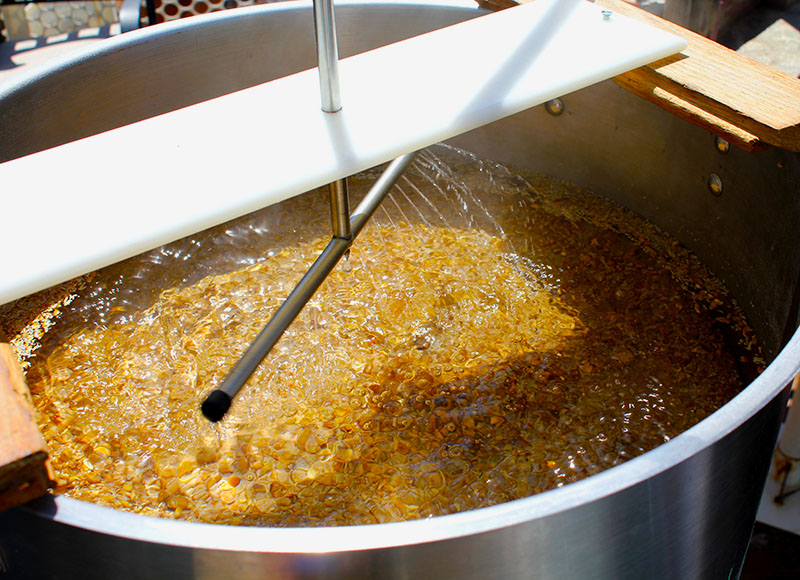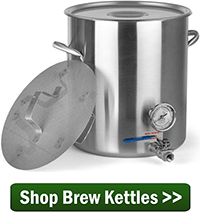 For all-grain brewers, sparging is the final step of the mash process when the grains are rinsed with hot water to remove the last remaining sugars from the mash. There are two sparging techniques: batch sparging and fly sparging. This article will explore the two methods and help you decide whether you should do a batch sparge or a fly sparge when homebrewing.
For all-grain brewers, sparging is the final step of the mash process when the grains are rinsed with hot water to remove the last remaining sugars from the mash. There are two sparging techniques: batch sparging and fly sparging. This article will explore the two methods and help you decide whether you should do a batch sparge or a fly sparge when homebrewing.
What is Fly Sparging?
Fly sparging is a sparging technique that is typical of the way many professional brewers rinse their grains. A rotating sparge arm or similar instrument delivers a shower of sparge water over the grain bed as wort is drawn from the bottom of the mash tun. The trick is to draw wort from the mash tun at the appropriate speed to “set” the grain bed so it can be used as a filter, and then start the flow of water from the sparge arm at a rate that does not flood the mash tun. Essentially, the liquid level inside the mash tun remains the same, with wort running out of the mash tun and water coming in through the sparge arm at roughly the same speed.
When trying to remember the difference between the two sparging techniques, I think of the sparge arm “flying” above the mash. If you’re into do-it-yourself projects, you may be interested in constructing your own rotating sparge arm. You can also simulate the fly sparging method by pouring your sparge water through a colander or screen over the mash. Though the fly sparge method is an efficient way of sparging your grains, a true fly sparge requires some additional equipment, time, and effort.
What is Batch Sparging?
By comparison, batch sparging is a sparging technique that is faster and simpler process. Instead of a constant rain of water over the grain bed, a batch sparge involves adding all of the sparge water at once – in one batch.
Typically, the homebrewer will first drain all of the wort from the mash into the brew kettle. These may be called the “first runnings”. Depending on your beer recipe, this may yield 50-70% of the total wort needed for the boil. Then the remaining volume of sparge water is added to the mash tun (some brewers will stir the grains) and drained into the brew kettle. If more wort is needed, you can always do another batch sparging.
For example, let’s say you’re brewing a five-gallon batch. You know that you want 5.5 gallons in the fermenter (the extra half-gallon to account for trub). From experience, you know that you boil off 1.5 gallons of wort during a sixty-minute boil, so you need to start with 7 gallons of wort in the brew kettle. After your mash, you’ve collected 3.5 gallons of wort in your brew kettle. Batch sparge with an additional 3.5 gallons of water (usually with the temperature in the ballpark of 165-170˚F) to reach your desired pre-boil volume.
So which sparging technique is better?
Neither the batch sparging method nor fly sparging method is inherently better than the other. It all comes down to what you prefer as a homebrewer. Fly sparging tends to get a slightly better brewhouse efficiency, but it requires extra time and equipment. Batch sparging is faster, but there’s a higher risk of losing efficiency.
than the other. It all comes down to what you prefer as a homebrewer. Fly sparging tends to get a slightly better brewhouse efficiency, but it requires extra time and equipment. Batch sparging is faster, but there’s a higher risk of losing efficiency.
Both of these sparging techniques will ultimately get the job done. Try them both and choose for yourself the method that works best for you.
Are you an all-grain homebrewer? Do you prefer a batch sparge or fly sparge?
—–
David Ackley is a beer writer, brewer, and self-described “craft beer crusader.” He holds a General Certificate in Brewing from the Institute of Brewing and Distilling and is founder and editor of the Local Beer Blog.

I have used both methods, but I prefer a modified batch sparge. I use a ten gallon cooler for mashing so there is a lot of head space above the grain. I normally add about half the sparge water after mashout, drain until clear and add that back. Then the remaining water is slowly poured on top of the mash so as not to agitate the grains too much. The water on top is relatively clear, so it’s almost like what you would get from a fly sparge. It’s also easy to maintain the water temperature. If a ten gallon batch is made the water is just added on top in increments instead of all at once based on available headspace. This has given me about the same brewhouse efficiency as when I fly sparged. I hope that this method can be used to ease someone’s brew day.
This article leaves out the effect on flavor. A batch sparge will supposedly give a more malty flavor profile. T13 I use batch spaging. I’ve do similar to yourself. I’ve been having problems with my mash bed temp going crazy low after washout. Am I suking too much air? Why the low temps in your Opion? TIA
rails2biedr, the only thing that expains it is air going through the sparge, or the thermometer is wrong. You may want to change your sparge method or compensate with warmer sparge water.